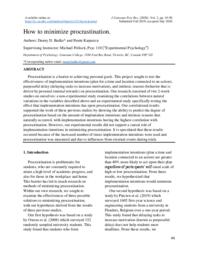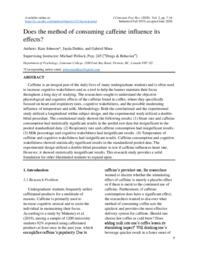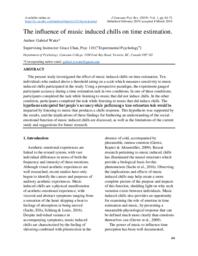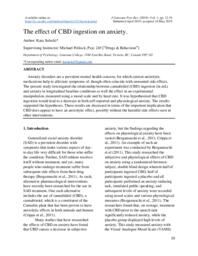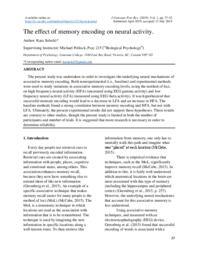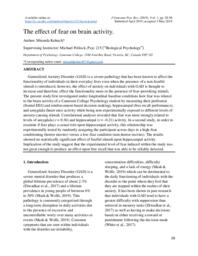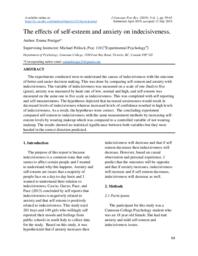article
Related Works
Content type
Digital Document
Description / Synopsis
Procrastination is a barrier to achieving personal goals. This project sought to test the effectiveness of implementation intentions (plan for a time and location connected to an action), purposeful delay (delaying tasks to increase motivation), and intrinsic reasons (behavior that is driven by personal internal rewards) on procrastination. Our research consisted of two 2-week studies on ourselves: a non-experimental study examining the correlations between natural variations in the variables described above and an experimental study specifically testing the effect that implementation intentions has upon procrastination. Our correlational results supported the work of these previous studies by showing the ability to predict the degree of procrastination based on the amount of implantation intentions and intrinsic reasons that naturally occurred, with implementation intentions having the highest correlation with procrastination. However, our experimental results did not support a causal role of implementation intentions in minimizing procrastination. It is speculated that these results occurred because of the increased number of times implementation intentions were used and procrastination was measured and due to influences from external events during trials.
Origin Information
Content type
Digital Document
Description / Synopsis
Caffeine is an integral part of the daily lives of many undergraduate students and is often used to increase cognitive wakefulness and as a tool to help the learner maintain their focus throughout a long day of studying. The researchers sought to understand the objective physiological and cognitive effects of the caffeine found in coffee, where they specifically focused on heart and respiratory rates, cognitive wakefulness, and the possible moderating influence of temperature and milk. Methodology: Both the correlational and the experimental study utilized a longitudinal within subject design, and the experimental study utilized a double-blind procedure. The correlational study showed the following results: (1) Heart rate and caffeine consumption had statistically significant results in the pooled raw data but insignificant in the pooled standardized data. (2) Respiratory rate and caffeine consumption had insignificant results. (3) Milk percentage and cognitive wakefulness had insignificant results. (4) Temperature of caffeine and cognitive wakefulness had insignificant results. Caffeine consumption and cognitive wakefulness showed statistically significant results in the standardized pooled data. The experimental design utilized a double-blind procedure to test if caffeine influences heart rate. However, it showed statistically insignificant results. This research study provides a solid foundation for other likeminded students to expand upon.
Origin Information
Content type
Digital Document
Description / Synopsis
The present study investigated the effect of music induced chills on time estimation. Ten individuals who ranked above a threshold rating on a scale which measures sensitivity to music induced chills participated in the study. Using a prospective paradigm, the experiment gauged participant accuracy during a time estimation task in two conditions. In one of these conditions, participants completed the task while listening to music that did not induce chills. In the other condition, participants completed the task while listening to music that did induce chills. The hypothesis anticipated that people’s accuracy while performing a time estimation task would be impacted by listening to music that produces a chills response. This hypothesis was supported by the results, and the implications of these findings for furthering an understanding of the social-emotional function of music induced chills are discussed, as well as the limitations of the current study and suggestions for future research.
Origin Information
Content type
Digital Document
Description / Synopsis
This study investigated the effect of incongruent audiovisual stimuli on people’s memory of written words. Twenty adults participating in the experiment were asked to memorize written words while discriminating the audio stimuli. In one condition, the video showed had congruent audiovisual stimuli while in the other condition, the video had incongruent audiovisual stimuli. The hypothesis was that people with video that had the same audio and visual would remember more words than the people with video that had conflicted stimuli. The results paired with the t-test indicated that the number of words recalled by the participants with matched audiovisual video is significantly higher than the number of words recalled by the participant with video that had different audio and visual. This supported the hypothesis showing that the auditory has an effect on word recalling. This finding can lead to future researches on improving memory by combining the audio and visual stimuli.
Origin Information
Content type
Digital Document
Description / Synopsis
Anxiety disorders are a prevalent mental health concern, for which current anxiolytic medications help to alleviate symptoms of, though often coincide with unwanted side effects. The present study investigated the relationship between cannabidiol (CBD) ingestion (in mL) and anxiety in longitudinal baseline conditions as well the effect in an experimental manipulation, measured using a mood scale and by heart rate. It was hypothesized that CBD ingestion would lead to a decrease in both self-reported and physiological anxiety. The results supported the hypotheses. These results are discussed in terms of the important implication that CBD does appear to have an anxiolytic effect, possibly without the harmful side effects seen in other interventions.
Origin Information
Content type
Digital Document
Description / Synopsis
The present study was undertaken in order to investigate the underlying neural mechanisms of associative memory encoding. Both nonexperimental (i.e., baseline) and experimental methods were used to study variations in associative memory encoding levels, using the method of loci, on high frequency neural activity (HFA) (measured using EEG gamma activity) and low frequency neural activity (LFA) (measured using EEG theta activity). It was hypothesized that successful memory encoding would lead to a decrease in LFA and an increase in HFA. The baseline methods found a strong correlation between memory encoding and HFA, but not with LFA. Ultimately, the present experimental results did not support these hypotheses. These results are contrary to other studies, though the present study is limited in both the number of participants and number of trials. It is suggested that more research is necessary in order to determine reliability.
Origin Information
Content type
Digital Document
Description / Synopsis
Generalized Anxiety Disorder (GAD) is a severe pathology that has been known to affect the functionality of individuals in their everyday lives even when the presence of a non-fearful stimuli is introduced, however, the effect of anxiety on individuals with GAD is thought to increase and therefore, effect the functionality more in the presence of fear-provoking stimuli. The present study first investigated under longitudinal baseline conditions how fear was related to the brain activity of a Camosun College Psychology student by measuring their prefrontal (frontal EEG and reinforcement-based decision making), hippocampal (free recall performance), and amygdala (heart rate) activity while being non-experimentally exposed to different levels of anxiety-causing stimuli. Correlational analyses revealed that fear was most strongly related to levels of amygdala (r = 0.36) and hippocampal (r = -0.21) activity. In a second study, in order to examine if fear plays a casual role upon hippocampal activity, this relationship was experimentally tested by randomly assigning the participant across days to a high-fear conditioning (horror movies) versus a low-fear condition (non-horror movies). The results showed no statistically significant effect of fearful stimuli upon hippocampal activity. Implication of the study suggest that the experimental level of fear induced within the study was not great enough to produce an effect upon free recall that was able to be reliably detected.
Origin Information
Content type
Digital Document
Description / Synopsis
The experiments conducted were to understand the causes of indecisiveness with the outcome of better and easier decision making. This was done by comparing self-esteem and anxiety with indecisiveness. The variable of indecisiveness was measured on a scale of one (bad) to five (great), anxiety was measured by heart rate of low, normal and high, and self-esteem was measured on the same one to five scale as indecisiveness. This was completed with self reporting and self measurements. The hypotheses depicted that increased anxiousness would result in decreased levels of indecisiveness whereas increased levels of confidence resulted in high levels of indecisiveness. As a result, the hypotheses were correct. The concluding experiment compared self-esteem to indecisiveness with the same measurement methods by increasing self-esteem levels by wearing makeup which was compared to a controlled variable of not wearing makeup. The results showed no statistical significance between both variables but they were headed in the correct direction predicted.
Origin Information
